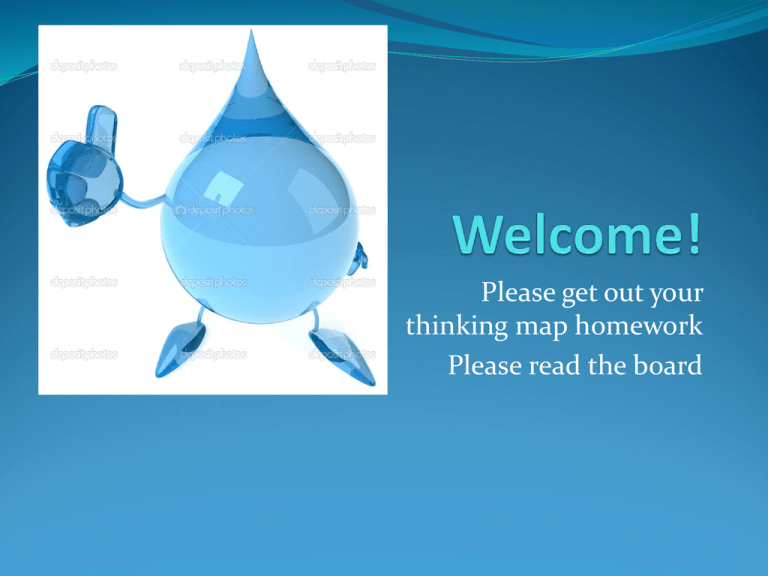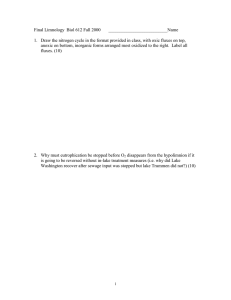Notes: 5 ways to meed demand and pathogens
advertisement

Please get out your thinking map homework Please read the board 5 Ways to increase water availability Build more dams – trap it upstream Use more groundwater Transfer water – pipe it long distances Desalinate water – take the salt out of sea water ◦ Reverse osmosis ◦ Distillation – boiling, then trapping the fresh steam Conserve water Texas’ Colorado River Thinking map 5 Ways to increase water availability (sustainably?????) Build more dams – trap it upstream Use more groundwater Transfer water – pipe it long distances Desalinate water – take the salt out of sea water ◦ Reverse osmosis ◦ Distillation – boiling, then trapping the fresh steam Conserve water Dams - How they work Texas’ ONLY natural lake – Caddo Lake Three Gorges Dam Yangtze River, China One of the world’s largest power plants Displaced 1.3 million people and flooded cultural/archeological sites Controls flooding downstream Aswan High Dam - Egypt Dams Advantages Disadvantages Use more groundwater Use more Groundwater – Ogallala Advantages Disadvantages Well, DUH!!!! Reverse osmosis Reverse osmosis Distillation Desalination in Tejas City of Seminole Project Cost: $1, 625, 000 Desalinating brackish groundwater from Dockum Aquifer using wind-power. California Water Transfer project Too much to say! We’ll save it for Friday! Two major topics: Water SUPPLY Water POLLUTANTS clean water Pollutant of the Day! Pathogens World Health Organization Statistics: Concerns: Improvements: 2.6 billion people do not have 84% of the population in adequately clean water rural habitants are 5 times less likely to use improved drinking water than those in urban centers. developing regions are using an improved source; in 2000, 1 billion more people used such a source than in 1990. UN-Water Decade Programme on Advocacy and Communication One out of four urban dwellers does not have access to improved sanitation facilities. 90% of all waste water in developing countries is discharged untreated, polluting rivers, lakes and seas. Every day, 2 million tons of sewage and other effluents drain into the world's waters Lake Conroe and Lake Houston: E. Coli bacteria – double the limit set by state Other Bacterial pathogens Typhoid – diarrhea, severe vomiting, inflamed intestines Cholera – diarrhea, severe vomiting Dysentery – diarrhea, usually only fatal in infants Giardia protezoan – diarrhea, cramps, fatigue Schistosomiasis – parasitic worm Guinea worm – burns as it leaves the human body 'Fiery serpent' ... A guinea worm emerges from the leg of a south Sudanese girl. (Reuters: Skye Wheeler, file photo) How are all of these passed on? Overloaded sewage treatment plants Direct dumping of sewage in communities Lack of water treatment plants The Life Straw LifeStraw Swiss-based Vestergaard Frandsen for tourists and people living in developing nations. There are several models of the product: LifeStraw Personal filters a minimum of 700 litres of water, enough for one person and one year. LifeStraw Family filters a minimum of 18,000 litres of water, providing safe drinking water for a family for more than two years. It removes 99.9999% of waterborne bacteria, 99.99% of viruses, and 99.9% of parasites. LifeStraw Personal kills 99.9999% of waterborne bacteria and 98.5% of viruses. Two types of sources • point sources – specific location that can be identified • nonpoint sources – spread out, may not be easy to identify. Coal-fired power plant Feedlot: Point or non point? Clear cut logging operation Agricultural fields Outfall effluent from sewage treatment plant City streets Active or abandoned mine Mine tailings piles/gangue Golf course Factory effluent Petroleum refinery Suburban lawns Storm drains Carry water from streets to local bayou/water way The drain is just for rain! Check for understanding!







